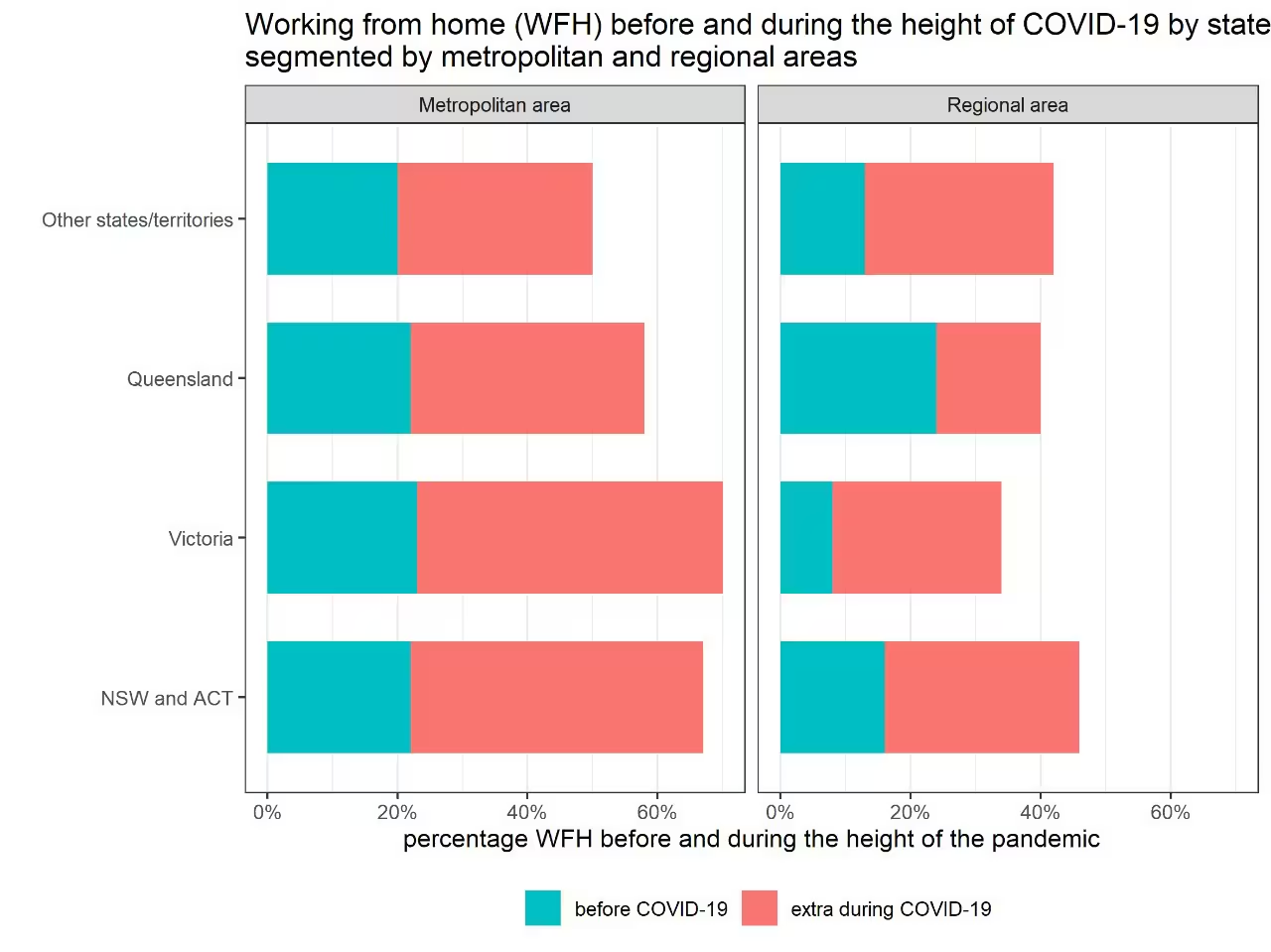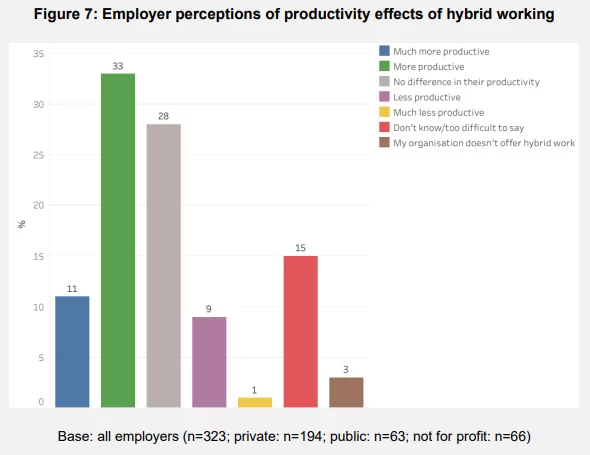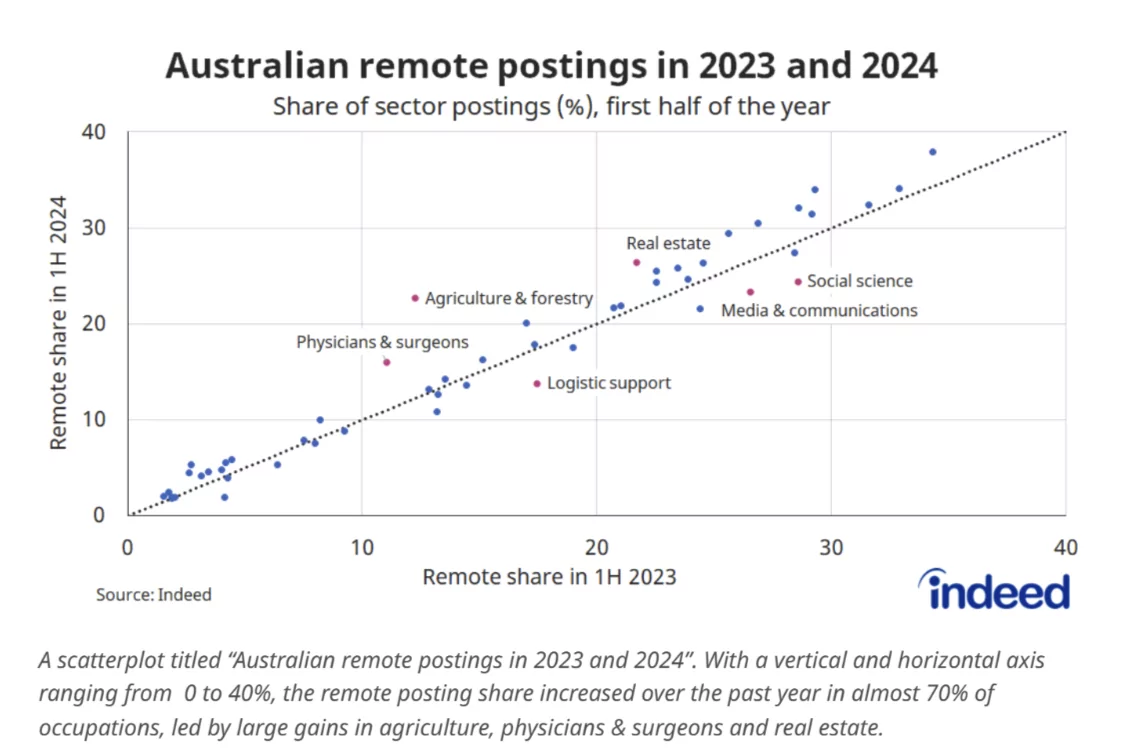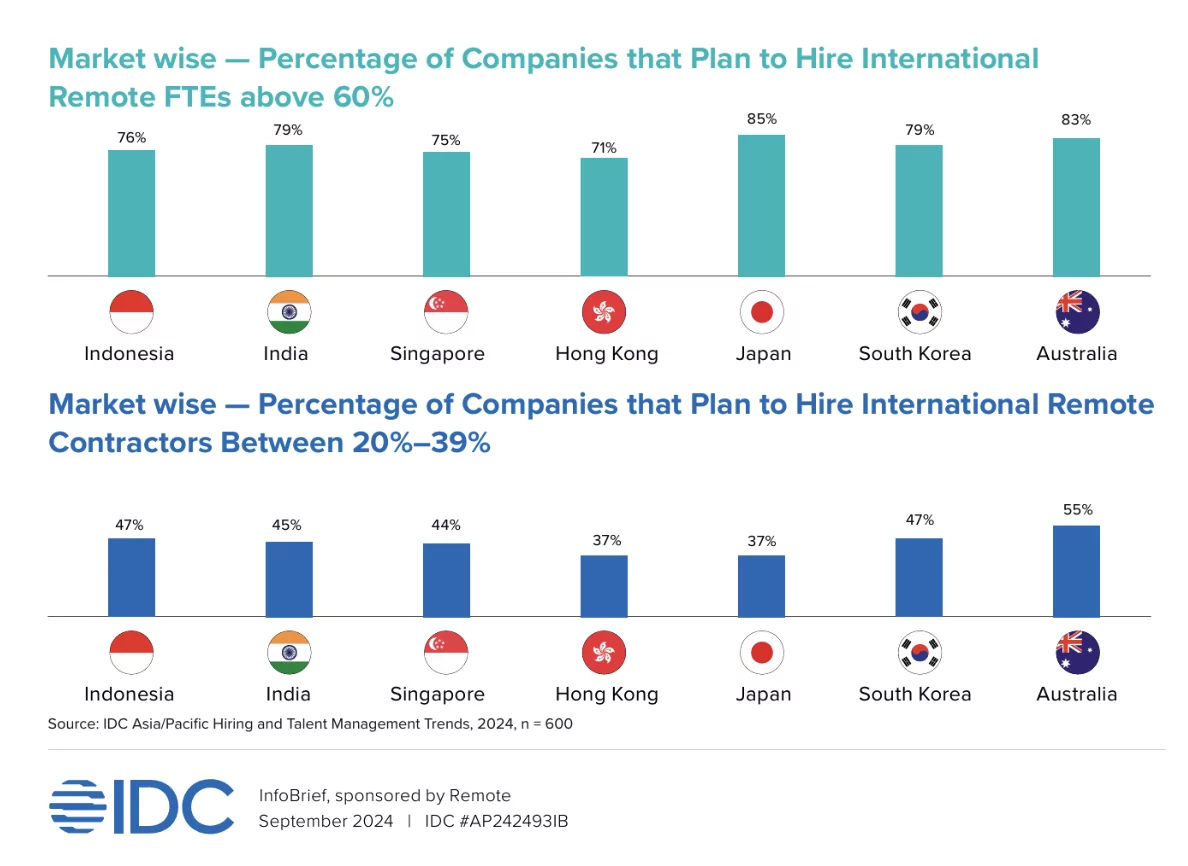
- Red Search
- Resources
- Remote Work & Working From Home Statistics
Remote Work & Working From Home Statistics Australia (2025)
-
 Daniel Law
Daniel Law
Remote work has long been common in Australia, but the COVID-19 pandemic marked a significant turning point for fully remote arrangements. Since 2020, work-from-home setups have reached record highs, prompting rapid digitalisation across industries—from traditional brick-and-mortar businesses to computer-based office roles.
Nearly four years later, remote work continues flourishing, showing no signs of slowing down. While evolving labour regulations increasingly favour flexibility for remote employees, not all employers are prepared to accommodate this shift.
The key question is whether Australia’s return-to-office movement will constrain remote work opportunities.
Let’s uncover the scale and impact of remote work in Australia and get insights into its growth trends, industry shifts, and future projections.
Growth of Remote Work in Australia: Key Statistics
Since the 1970s, around 15% of employed Aussies have had to work from home, though this could be at least a few hours or days per week. Between 1989 and 2008, it jumped to 20-30% of people, with only 4-8% spending most of their work hours at home.
Source: Australian Bureau of Statistics
Before March 2020, the percentage of Aussies working from home steadily increased by about one percentage point every two years, per the ABS report. Until it peaked at 40% in 2021, with 20-30% reported working from home all or most days.
However, with COVID restrictions lifted, data shows 37% of Australians worked from home in 2023, still up 5% from the pre-pandemic. This shift in working arrangements has continued beyond the pandemic but slightly declined to 36.3% in 2024.
Growth Over The Years
Australians are no strangers to remote work. It notably boomed in 2015, with nearly 30% of Aussies embracing work from home. Steadily rising in popularity, it hit a record peak, with 40% of employees working from home in 2021 – roughly 2.5 times as high as before the pandemic.
Source: Australian Bureau of Statistics
This sustained rate suggests working from home may not dwindle to pre-pandemic levels.
Although it slightly declined, about 88% of Australians prefer to work from home at least partially. Similar survey data reveals that 60% prefer hybrid work, with flexible access to work in both the office and at home.
Regional Variations
According to ITLS, one in five Australian employees worked from home pre-pandemic. After the coronavirus outbreak, more Aussies prefer to work from home an average of two days per week, though remote work adoption varies across the country.
Among Victorian employees, 20% adopted work from home before COVID-19, plus 45% during. NSW has seen a similar rate, though only an extra 39% worked remotely during the pandemic. Employees living in metropolitan cities worked from home more throughout the outbreak than their regional counterparts.
 Source: The University of Sydney
Source: The University of Sydney
Although remote work has increased by 30% in most regional areas, Queensland has seen the least uptick at 16%. While these figures may dwindle slightly post-pandemic, it indicates that regional areas often have lower remote work rates.
One prime reason is employers pay remote workers less than those living in metro areas, discouraging remote work adoption in those regions.
Impact of Remote Work on Employee Productivity & Satisfaction
Flexibility remains crucial to building employee satisfaction and retention as in-office attendance returns. Melbourne Institute and Roy Morgan reveal that, in 2023, roughly 40% of Australian workers desire a larger workweek at home than their employer permits.
The same survey shows that employers are twice as likely as workers to prefer everyone in the office full-time. Meanwhile, a quarter of employers permit work from home 76% of the time, though workers only prefer 42% of the time (2.1 days per week).
While it’s clear most workers prefer hybrid or remote work, it’s still inapplicable to all sectors.
Working From Home Productivity Statistics
In a report from HILDA, 3 in 5 Aussie respondents indicated the same or better productivity following increased hours working from home. While only 24% reported a positive impact, about 33% had seen no change in productivity.
At worst, 42% reported negative impacts. This is not surprising, as the report mirrored the earlier months of the pandemic, forcing most to work from home at short notice with inadequate workstations. Given that these figures are self-reported, employers may have a different view.
Based on employers’ perceptions, more than 4 in 10 employers (43%) viewed the switch to remote or hybrid working as positively impacting productivity. More than a quarter (28%) say such work arrangement has no impact, while 10% think it had a negative effect.
 Source: AHRI
Source: AHRI
Challenges of Working From Home
Access to flexible work is a critical retention factor for employees at work. Statistically, 3 out of every 4 prime-aged Aussie workers (under age 54) reported that a lack of flexible working options often motivates them to leave or find other jobs.
While employers must carefully enforce strict return-to-office mandates, remote work has its pitfalls. Despite its perceived benefits, around 2 in 5 flexible workers miss their colleagues.
This coincides with the biggest issue employers face, with 75% of organisations reporting disconnectedness between colleagues. Other hurdles of remote working that employers reported include staff collaboration (58%), monitoring performance (43%), and mentoring (40%).
Industries Leading the Remote Work Charge in Australia
As more revert to better flexible options, 45% of Aussies believe remote work will reshape the workforce landscape. Although only 10% favour traditional work arrangements, this further suggests companies are open to global talent pools. Which industries benefit from remote work?
Tech & IT Sector
Australia’s tech sectors lead the adoption of remote work, with 74% of tech companies seeing a high demand for flexible work options. Even with flexible arrangements, roughly 58% of these firms are losing employees to competitors that provide even more flexible work options, as Remote’s 2024 Global Report indicated.
Australian tech companies excel in flexible work models. About 54% of tech companies offer flexible working hours, 44% part-time, and 46% remote work. These sectors benefit highly from remote operations, propelling higher employee satisfaction (46% vs 35%) and business performance (43% vs. 29%) compared to other industries.
Other Prominent & Emerging Sectors
The top sectors involving information technology, back-office functions (e.g., finance, marketing), and customer services have historically benefited from remote operations, even before the pandemic. While there’s no concrete data for emerging sectors, job postings can give hints.
The top sectors involving information technology, back-office functions (e.g., finance, marketing), and customer services have historically benefited from remote operations, even before the pandemic. While there’s no concrete data for emerging sectors, job postings can give hints.
Global platform Indeed has seen an increased remote posting share in nearly 70% of all occupational categories in Australia, with a sharp rise in both high- and low-remote jobs. Agriculture and forestry have the highest remote posting share, from 12.2% to 22.7% (Q1 2023 vs. 2024).
Following this were remote job postings for physicians or surgeons (11% to 16%) and real estate (21.7% to 27.6%). Remote posting share significantly declined in social science (-4.1%), logistic support (-3.6%), and media and communications (-3.1%) within the same period.
 Source: Indeed Hiring Lab Australia
Source: Indeed Hiring Lab Australia
The Future of Remote Work in Australia: Trends & Forecasts
As demand for remote work options tightens, Australian companies adopt a borderless digital workspace. However, this reimagined workplace has many hurdles, from hiring and paying top talents overseas to different labour laws and skill gaps.
Let’s glimpse at how Australia leans forward the future of remote work.
Remote Work in 2025 & Beyond
Australia ranks first in hiring maturity for remote workforce in Asia-Pacific, according to the IDC 2024 InfoBrief.
In fact, 83% of surveyed companies plan to hire international remote full-time employees (FTEs) in the next 12-18 months. Only 55% of firms plan to recruit contractors for remote work, slightly higher than other countries.
 Source: IDC InfoBrief
Source: IDC InfoBrief
While these are promising, payroll management and policy compliance remain the top issues for hiring internationally. On the spectrum’s other end, more employees embrace digital nomadism, letting them work remotely at their dream destinations.
In a 2024 YouGov survey, 1 in 3 Aussie digital nomads have travelled at least for one week while working remotely.
Technology & Infrastructure
Advances in technologies are dismantling most barriers to remote work. While nearly 6 in 10 employers worry about staff collaboration in remote setups, platforms like Slack, Zoom, and Asana enable real-time collaboration. These tools further streamlined remote work, mimicking in-person offices.
With smartphones’ innovative features, remote work is no longer confined to home offices. It provides greater mobility and flexibility to work anywhere with ease. With remote teams being fully digital, robust cybersecurity is critical to thwart potential data breaches and cyberattacks.
Changes in Employer Expectations
Given Australia’s tight labour market, employers offer flexible work as a powerful recruitment tool to attract the best talents. So, will employers remain accommodating with remote work options if market condition shifts in their favour?
Even if the labour market softens, federal bills passed in 2023 give Aussie employees more rights to flexible work. AHRI research reveals nearly half (47%) of employers say workers can request flexible work from day one. Another 17% of surveyed firms provide flexible working after 12 months.
Despite the legislative changes, similar data highlights only 26% of organisations are more likely to grant flexible work requests. Unless there are reasonable grounds, employees can go off to the independent umpire at the Fair Work Commission following a disagreement on flexible work options.
Common Pitfalls of Remote Work in Australia & How to Avoid Them
While the shift towards remote work unlocks many benefits, it has its fair share of downsides. On top of that, 1 in 10 Australian jobs are at risk of being automated or replaced by artificial intelligence.
Business owners must address a few pitfalls to thrive in the remote work sphere.
Communication Breakdowns
In the absence of face-to-face interactions, communication gaps are common. Virtual teams often rely on technology-mediated communication with delays, misinterpretations, or lack of non-verbal cues.
Organisations must invest in appropriate communication tools and establish clear information exchange protocols to overcome these barriers.
Burnout & Overwork
Since the pandemic’s onset, Australia’s prime-aged workforce is working harder, exhausted, and less motivated. Isolation, lack of social support, and blurred work-life boundaries contribute to more stress and burnout among remote employees.
Organisations must promote work-life balance, encourage regular breaks, and provide resources to foster employees’ holistic well-being.
Lack of Structure & Accountability
Remote employees may struggle with time management and maintaining focus without a structured work routine. To counteract these, managers should establish clear performance metrics, set time-bound expectations, and provide ongoing feedback to ensure accountability.
By addressing these pitfalls, organisations and individuals can unlock the full potential of remote work. Remote work options will stay, offering unmatched flexibility, productivity, and connectivity for businesses to succeed in cyberspace.
For more on Australian statistics, see our other articles:
- Australian Mobile Phone Statistics
- Australian Internet Statistics
- Australian Local SEO Statistics
- Australian ChatGPT Statistics
- Australian VPN Statistics
- Australian Youtube Statistics
- Blogging Statistics
Frequently Asked Questions
1. What are the biggest challenges of remote work in Australia?
According to the Australian HR Institute, the sense of disconnectedness between colleagues remains the top barrier to remote or hybrid work. This reduced face-to-face interaction, isolation, or loneliness often impacts employees’ focus, well-being, and job satisfaction.
2. How has the Australian government supported remote workers?
Australia passed laws that cater to work flexibility as part of the Secure Jobs, Better Pay bill. This requires employers to accommodate remote work requests received from employees. While employers can refuse such requests, employees can seek aid from the Fair Work Commission to review and order a change if refusal has no reasonable grounds.
3. What industries have seen the biggest shift to remote work?
While actual figures are elusive, the tech sector was the first to embrace remote work. This reflects why almost one-third of tech job postings explicitly mentioned remote work up to this day. Other notable industries seen with the highest remote job postings include agriculture and forestry (up +10.5%), physicians and surgeons (up +5%), and real estate (up +4.7%).
4. Are businesses saving money by having remote employees?
From an employer’s standpoint, remote work adoption means saving office spaces, utilities, and overhead expenses. Though providing appropriate technologies and work setups may incur additional costs, remote options ensure employee retention and attract wider talent pools.
5. How do remote employees stay productive in isolation?
Establishing a conducive workspace, structured work routine, and regular communication helps employees stay productive even when working in isolation. While there’s a risk employees could slack off, putting good systems in place ensures each employee’s accountability and wellness at work.
Written by






